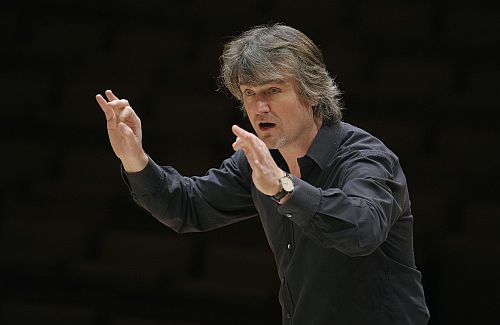
 Germany Gershwin, Ives, Antheil and Bernstein: Pierre-Laurent Aimard (piano), Ernst Senff Choir, Berlin Philharmonic Orchestra/Ingo Metzmacher, Philharmonie, Berlin, 8.9.2012 (MC)
Germany Gershwin, Ives, Antheil and Bernstein: Pierre-Laurent Aimard (piano), Ernst Senff Choir, Berlin Philharmonic Orchestra/Ingo Metzmacher, Philharmonie, Berlin, 8.9.2012 (MC)
George Gershwin – Cuban Overture (1932)
Charles Ives – Symphony No. 4 (1910/16)
George Antheil – A Jazz Symphony (1955 version)
Leonard Bernstein – Symphonic Dances from West Side Story (1957, arranged 1960)

Conductor Ingo Metzmacher has made an impressive reputation for himself with his recordings of modern music and works away from the standard repertoire; CDs of Cage, Ives; Hartmann and Henze spring to mind. With tonight’s twentieth-century all-American programme Metzmacher was in his element directing the Berlin Philharmonic which, if it was a prestige marque vehicle, would be a cross between a Rolls Royce and a Ferrari.
The concert opened as it meant to go on with George Gershwin’s highly colourful Cuban Overture. Originally titled ‘Rumba’, the symphonic poem was a product of Gershwin’s holiday in 1932 in Havana, Cuba. Heavily infused with Latin-American textures – essentially rumba and habanera rhythms with a parade of exotic Cuban percussion – Metzmacher and his Berlin players revelled in this feel good score displaying their unmistakable versatility.
The most substantial work of the evening was the Symphony No. 4 for orchestra and chorus from the pen of maverick Connecticut-born composer Charles Ives. Ives was an individualist who followed his own path unafraid of experimentation, and his music predated many significant twentieth-century innovations. For large orchestra and chorus the complex fourth Symphony is Ives at his most typical containing overlapping multi-layered, highly colourful canvasses of sound, and it is a work that I enjoy hearing occasionally in the concert hall. Composed in 1910/16 Ives draws on a parade of influences both tonal and atonal, such as traditional folk songs, parlour ballads, Protestant revival hymn tunes, competing marching military bands, raucous country barn dances and two groups of off-stage players.
Owing to the complex nature of the writing in the second movement a second uncredited conductor was used – one of the woodwind players, if I‘m not mistaken. Consisting of highly percussive effects, including at one point a parody of a drunken bar pianist, the piano part was played by Pierre-Laurent Aimard. One might wonder why an international concert pianist was engaged for such an eccentric piano role, but immediately after this concert Aimard was playing Ives’s substantial Piano Sonata No. 2 ‘Concord Sonata’ in a late night recital also held in the Philharmonie.
Close to the very start of the opening movement Ives has the choir, in this case the Ernst Senff Choir, sing the John Bowring hymn Watchman, tell us of the night. The choir then remain silent until close to the very end with wordless singing. Maybe having to sing at the start and wait until the very end is Ives’ idea of a joke on the choir. I feel that you have to buy into Ives’s music even when it seems its most ridiculous, such as when its various forces are pulling against one another, or else its duration can be uncomfortable for the listener. Both stylishly and technically Metzmacher did remarkably well to bring all the diverse forces together with his Berlin players and choir giving Ives’s music their greatest care and respect.
After the interval came George Antheil’s A Jazz Symphony from 1925 a commission from Paul Whiteman that successfully and originally marries the jazz band elements to the classical concert orchestra. It was good to finally hear the A Jazz Symphony in the concert hall with Metzmacher opting for Antheil’s 1955 revised version with expanded instrumentation. No one should be put off by Antheil’s self proclaimed “bad-boy of music” tag as the work is easily accessible and can be savoured at its fullest in the appropriate context such as this all-American concert at the Philharmonie. Metzmacher’s Berlin players were clearly relishing Antheil’s enjoyable and entertaining writing, playing the unremitting and often frenzied rhythms and colourful textures with a natural exuberance and bringing an uplifting freshness to the score.
The proverbial icing on the cake was the performance of Leonard Bernstein’s 1960 arrangement the Symphonic Dances from the composer’s magnum opus – the wildly successful Broadway musical West Side Story. Right from the opening bars of the Prelude the Berlin players demonstrated that they not only can play this music but can also impressively swing through it. Heavily covered over the years in the pop charts Somewhere, one of Bernstein’s greatest melodies, was conveyed so affectionately it raised the hairs on the back of the neck. The foot-tapping Mambo was tremendously exhilarating performed with significant weight and impressive unity. In the light and elegant Cha-cha scene Metzmacher was so involved he was virtually dancing on the podium and the tender playing in the romantic Meeting Scene was as soft as featherdown.
This was a magnificent evening at the Philharmonie. It was wonderful to watch as well as hear one of the most famous orchestras in the world, the Berlin Philharmonic, perform this enthralling and entertaining all-American programme.
Michael Cookson